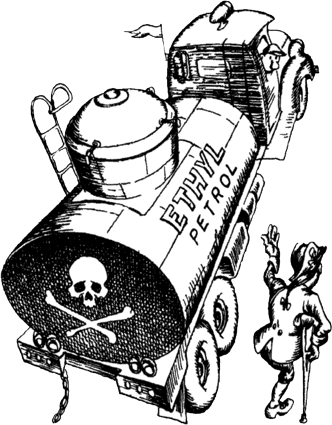107Stories About ChemistryINDEX |
67.
The Story of TEL
TEL is an abbreviation. It is the name of a compound which is very useful in the practical activities of man. It helps to save petrol. Nobody has ever counted up exactly how many litres of petrol TEL has saved throughout its history, but it doubtlessly amounts to a very impressive figure. What is this mysterious TEL? A chemist would say: an organometallic compound of the hydrocarbon ethane with the metal lead Remove a hydrogen atom from each of four molecules of ethane (C2H6) and add the resulting hydrocarbon radicals (ethyls C2H5) to a single lead atom, and you get the molecule of a substance with the fairly simple formula Pb(C25)4). It is called tetraethyllead, or TEL for short. TEL is a heavy liquid slightly greenish in colour with the hardly perceptible odour of fresh fruit, but it is far from harmless. It is one of the most potent poisons. In itself TEL is nothing to speak of. It is much like any other substance; chemists know of far more remarkable compounds. But add only half of one per cent of TEL to a tank of motor petrol, and the wonders begin. The heart of any automobile or aeroplane is its internal-combustion engine. Its principle of operation is simple. A mixture of petrol and air is compressed in a cylinder. Then it is ignited by means of an electric spark. An explosion occurs and energy is evolved, making the engine work. Much depends on the compression ratio of the mixture. The higher this ratio the greater is the power of the engine, and the more economically is the fuel used. That is the theory, in practice, however, we cannot compress the mixture as greatly as we should like to. This results in �disorders� of the engine: owing to incomplete, non-uniform combustion of the fuel the engine becomes overheated, its parts wear out rapidly, and it consumes petrol at a prohibitive rate. Improvements in engine design and purer grades of petrol alleviated the �disorder� somewhat, but did not cure it. Motors continued to �knock� and overheat; nonuniform explosions of the mixture (detonations) shortened their service life. After a great deal of thought scientists came to the conclusion that detonation could be suppressed and the mixture could be made to burn uniformly only by altering the properties of the fuel. But how? Thomas Midgley, an American chemist, put a great deal of effort into the study of this question. The first solution he suggested came as a complete surprise. He claimed that if the petrol were coloured red it would be able to absorb more heat and would become more volatile. This would enable stronger compression of the fuel-air mixture. Midgley �coloured� petrol by adding a little iodine to it. And what was his delight to find that the petrol actually began to detonate less. But when ordinary paint was substituted for the iodine the motor again fell victim to its old troubles. Hence, colour had nothing to do with it. However, Midgley�s chagrin was short-lived. He hit on the brilliant idea that there probably must be substances, insignificant additions of which could improve the quality of petrol considerably. Iodine did this only slightly. Other substances, simple or complex, had to be sought. Scientists tested tens and hundreds of compounds. Scientists and engineers worked side by side. Finally the scientists came to the very important conclusion that antiknock agents must be sought among the compounds of elements of high atomic weight. For instance, lead compounds might be tested. But how can lead be introduced into petrol? Neither the metal itself nor any of its salts are soluble in petrol. The only possible way is to use some organic compound of lead. It was then that the word �tetraethyllead�, TEL, was first pronounced. That was in 1921. Insignificant additions of TEL to petrol worked wonders. Fuel quality improved sharply. Fuel-air mixtures could now be compressed twice as much as before. This meant that with the vehicle moving at the same speed the petrol consumption would be only half of what it was formerly. Misfires were eliminated from automobile and aeroplane motor operation. And here is a curious economic note: the world production of TEL is now so high that the natural resources of lead are under hazard. A very troublesome property of TEL is its high toxicity. You have probably seen tank trucks with the inscription: �ETHYL PETROL. POISON�. Petrol containing TEL must be handled with great care.  TEL was the pioneer among antiknock agents, and is still the most important of them. But scientists are giving serious thought to the problem of replacing it by some other substance just as effective, but harmless. One such substance has already been discovered. It is called CMT. If you want to know what this means, read the next story. |





